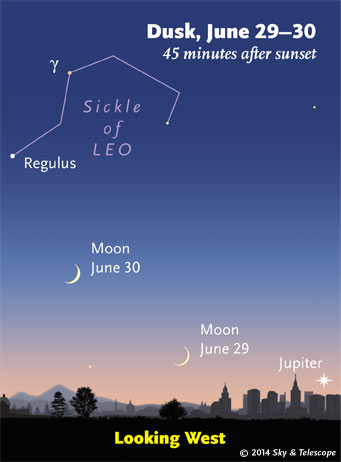
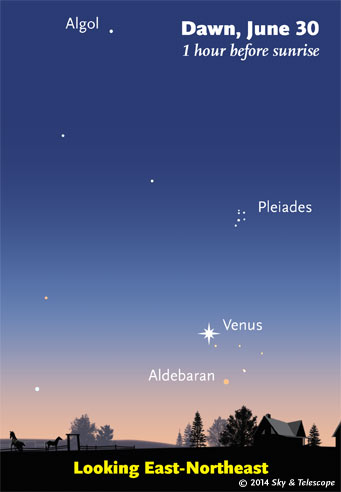
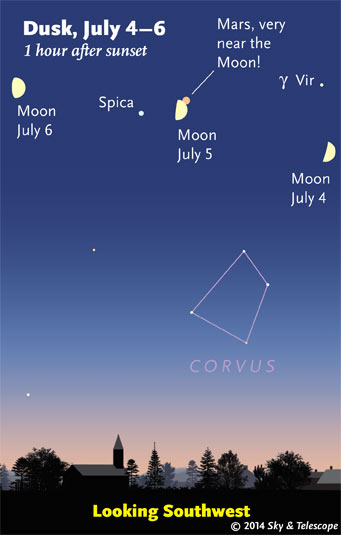
Friday, June 27
This is the time of year when, at the end of dusk, the dim Little Dipper floats straight upward from Polaris (the end of its handle) — like a helium balloon on a string, escaped from some summer evening party. Look due north. (Through light pollution, all that you may see of the Little Dipper are Polaris at one end and Kochab, the lip of the Little Dipper's bowl, above it at the other end.)
Saturday, June 28
Can you see the big Coma Berenices star cluster from where you live? Does your light pollution really hide it, or do you just not know exactly where to look? It's 2/5 of the way from Denebola (Leo's tail) to the end of the Big Dipper's handle (Ursa Major's tail). Its brightest members form an inverted Y. The cluster is about 5° wide overall — a big, dim glow in at least a moderately dark sky. It nearly fills a binocular view.
If you have a good dark sky, look east after the final glow of twilight fades out. All across the low eastern sky on any clear night now, the starry, mottled band of the Milky Way is looming up. It rises higher through the night and crosses straight overhead around 3 a.m.
Sunday, June 29
Shortly after sunset, look for the thin waxing crescent Moon very low in the west-northwest, then look for Jupiter well to its right, as shown here.
Monday, June 30
Now the thickening crescent Moon is higher and easier to see in twilight, with Jupiter farther to its lower right and stars of Leo above it, as shown here.
Tuesday, July 1
Ceres and Vesta at their closest. The two leading asteroids, currently magnitudes 8.4 and 7.1, are closing right in on each other as seen on the sky. They're not far above Mars and Spica after dark. They are within 1/3° of each other for the next week and will appear closest together, just 1/6° apart, on the evenings of July 4th and 5th. See the article in the July Sky & Telescope, page 50. Here's a printable Ceres and Vesta finder chart.
Wednesday, July 2
Can your scope separate a double star 1.0 arcsecond wide? High overhead, 44 Bootis provides a fine test! And one of its components is a weird variable star too. See the article and chart in the July Sky & Telescope, page 52.
Thursday, July 3
Vega is the brightest star very high in the east these evenings. The brightest to its lower left is Deneb. Farther to Vega's lower right is Altair. These make up the big Summer Triangle. If you have a dark sky, you can see that the glowing band of the Milky Way runs through it.
Earth is at aphelion, its farthest from the Sun for 2014. But it's only 3% farther than at perihelion in January; Earth's orbit is nearly round and nearly centered on the Sun.
Friday, July 4
Out to watch fireworks? As you're waiting for twilight to end, spot the Moon in the west-southwest with Mars and Spica off to its left, as shown here. High above them all shines brighter Arcturus. Point these out to your family!
Ceres and Vesta appear just 1/6° apart this evening and tomorrow evening; see July 1 above.
Saturday, July 5
First-quarter Moon. The half-lit Moon is quite close to Mars as seen from North America. The Moon occults (hides) Mars during daylight for Hawaii and at dusk or night in parts of Latin America; map and timetables.
Want to become a better astronomer? Learn your way around the constellations. They're the key to locating everything fainter and deeper to hunt with binoculars or a telescope.
This is an outdoor nature hobby; for an easy-to-use constellation guide covering the whole evening sky, use the big monthly map in the center of each issue of Sky & Telescope, the essential guide to astronomy. Or download our free Getting Started in Astronomy booklet (which only has bimonthly maps).

Once you get a telescope, to put it to good use you'll need a detailed, large-scale sky atlas (set of charts). The standards are the little Pocket Sky Atlas, which shows stars to magnitude 7.6; the larger and deeper Sky Atlas 2000.0 (stars to magnitude 8.5); and once you know your way around, the even larger Uranometria 2000.0 (stars to magnitude 9.75). And read how to use sky charts with a telescope.
You'll also want a good deep-sky guidebook, such as Sue French's Deep-Sky Wonders collection (which includes its own charts), Sky Atlas 2000.0 Companion by Strong and Sinnott, the bigger Night Sky Observer's Guide by Kepple and Sanner, or the beloved if dated Burnham's Celestial Handbook.
Can a computerized telescope replace charts? Not for beginners, I don't think, and not on mounts and tripods that are less than top-quality mechanically (able to point with better than 0.2° repeatability, which means fairly heavy and expensive). As Terence Dickinson and Alan Dyer say in their Backyard Astronomer's Guide, "A full appreciation of the universe cannot come without developing the skills to find things in the sky and understanding how the sky works. This knowledge comes only by spending time under the stars with star maps in hand."
This Week's Planet Roundup
Mercury is deep in the glow of sunrise, far lower left of Venus.
Venus (magnitude –3.9, In Taurus) shines low in the east during dawn. It's in the vicinity of the Pleiades and Aldebaran.
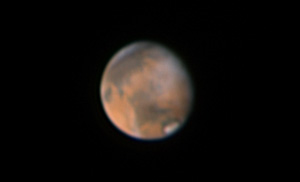
Mars (magnitude 0.0, in Virgo) is high in the southwest in twilight, with Spica to its left. Watch Mars move closer to Spica every day! They set in the west after midnight.
In a telescope, Mars's gibbous disk is about 9.5 arcseconds tall and shrinking. Use our Mars Profiler to find which side of the planet will be facing Earth when you plan to look.
Jupiter (magnitude –1.8, in Gemini) is low in the west-northwest after sunset and sets during twilight. Binoculars will help.
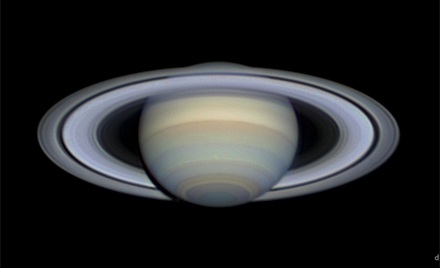
Saturn (magnitude +0.4, in Libra) glows in the south during evening. The wide binocular double star Alpha Librae glimmers to Saturn's lower right. Look for Antares and the head of Scorpius down to Saturn's lower left.
In a telescope Saturn's globe is 18 arcseconds wide, and its rings are tilted 21° from our line of sight. Use our SaturnMoons app to find and identify Saturn's various satellites at any time and date. A 6-inch scope will show four or five of them: Titan, Rhea, Dione, Tethys, and sometimes Iapetus.
Uranus, in Pisces, and Neptune, in Aquarius, are well up in the southeast before the first light of dawn. Use our finder charts for Uranus and Neptune in 2014.
----------------------------------
All descriptions that relate to your horizon — including the words up, down, right, and left — are written for the world's mid-northern latitudes. Descriptions that also depend on longitude (mainly Moon positions) are for North America.
Eastern Daylight Time (EDT) is Universal Time (UT, UTC, or GMT) minus 4 hours.
 4
4
Comments
David Dunn
June 30, 2014 at 3:32 pm
I was with my Astronomy Club the other night - high in the Sierra Nevada mountains. We had a wonderful view of the sky and several people took wonderful shots of the Milky Way. We did not stay until 3 am, to see the Milky Way pass overhead, but we were there late enough to see stretch across the eastern and southern skies. Wonderful experience!
You must be logged in to post a comment.
mary beth
July 1, 2014 at 1:04 am
That's wonderful you had such a fantastic night! Your description reminded me of a paragraph from Henry Beston's 'The Outermost House' - "Night is very beautiful on this great beach. It is the true other half of the day's tremendous wheel; no lights without meaning stab or trouble it; it is beauty, it is fulfillment, it is rest. Thin clouds float in these heavens, islands of obscurity in a splendor of space and stars: the Milky Way bridges earth and ocean; the beach resolves itself into a unity of form, its summer lagoons, its slopes and uplands merging; against the western sky and the falling bow of sun rise the silent and superb undulations of the dunes.”
Bet you wanted to stay til dawn! What a blessing that must have been! I've never seen it. Is that the best viewing you have ever had?
You must be logged in to post a comment.
David Dunn
July 1, 2014 at 1:25 am
You've never seen the Milky Way?! Oh my, you need to get far from the city and look at it with your own eyes! I've seen it from this location before - but it was very clear. I've also been another place in the Sierras that was also very good. Both places has some light pollution from Sacramento, so it wasn't totally dark, but very nice.
Nice quote! And thank you for the Sky and Telescopes from 1976 - that was very nice of you!!!!
You must be logged in to post a comment.
mary beth
July 1, 2014 at 11:25 am
Life of a City Girl ....sigh!!
Glad you got the issues. I googled your name and 'astronomy' and found you lol. I was only going to get Feb and March but for a few dollars more this other lady on eBay had the whole year! I figured Comet West's monumental appearance warranted articles the entire year anyway. (Plus nicer to have a complete set IMHO). I bought a few issues myself. I see they have digital issues in the S&T store, even some from the 1930s! I think I might eventually buy the entire library they have as a package deal.
We finally had clear skies last night after almost a week of clouds. I know July is here when I can see The Cat's Eyes right after dark :)!
You must be logged in to post a comment.
You must be logged in to post a comment.